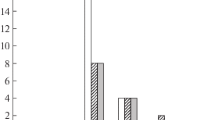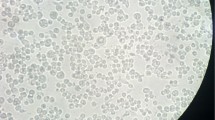Abstract
The effect of ethanol on cells infected with mouse hepatitis virus (MHV) was investigated. After MHV infection of competent cells, NCTC1469, ethanol was added to the culture at various concentrations, and the viability of cells was measured using 3-(4,5-dimethylthiazol-2yl)-2,5-diphenyltetrazolium bromide. To examine the possible involvement of the ethanol metabolite, acetaldehyde, alcohol dehydrogenase activity was measured in NCTC1469 cells. Ethanol alone did not show cytotoxicity against NCTC1469 cells at concentrations from 0.125% to 2%. After infection with MHV, the viability of cells decreased, and this decrease was further enhanced, dosedepependently, by the addition of ethanol. The activity of alcohol dehydrogenase in the cells was below the detectable level. The same phenomena were also demonstrated in cells infected with influenza virus andHerpes simplex virus. These results demonstrate that ethanol enhances MHV-mediated cytotoxicity; this exacerbation of cytotoxicity by ethanol is suggested to be an effect common to cytopathic virus-infected cells.
Similar content being viewed by others
References
Shiomi S, Kuroki T, Minamitani S, et al. Effect of drinking on the outcome of cirrhosis in patients with hepatitis B or C. J Gastroenterol Hepatol 1992;7:274–276.
Suzuki M, Suzuki H, Mizuno H, et al. Studies on the incidence of hepatocellular carcinoma in heavy drinkers with liver cirrhosis. Alcohol Alcoholism 1993;28:109–114.
Oshita M, Hayashi N, Kasahara A et al. Increased serum hepatitis C virus RNA levels among alcoholic patients with chronic C. Hepatology 1994;20:1115–1120.
Takase S, Takada N, Sawada M, et al. Relationship between alcoholic liver disease and HCV infection. Alcohol Alcoholism 1993;28:77–84.
Nalpas B, Feitelson M, Brechot C, et al. Alcohol, hepatotropic viruses, and hepatocellular carcinoma. Aleohol Clin Exp Res 1995;19:1089–1095.
MacGregor RR. Alcohol and immune defense. JAMA 1986;256:1474–1479.
Vicente-Gutierrez MM, Diez-Ruiz A, Gil-Extremera B, et al. Low serum levels of alpha-interferon, gamma-interferon, and interleukin-2 in alcoholic cirrhosis. Dig Dis Sci 1991;36:1209–1212.
Chadha KC, Whitney RB, Cummings MK, et al. Evaluation of interferon system among chronic alcoholics. In: Seminara D, Watson RR, Pawlowski A (eds) Alcohol, immunomodulation, and AIDS. New York: Alan R Liss 1990;123–133.
Ochshorn-Adelson M, Bodner G, Toraker P, et al. Effects of ethanol on human natural killer cell activity: In vitro and acute, low-dose in vivo studies. Alcohol Clin Exp Res 1994;18:1361–1367.
Gallucci RM, Pfister LJ, Meadows GG. Effects of ethanol consumption on enriched natural killer cells from C57BL/6 mice. Alcohol Clin Exp Res 1994;18:625–631.
Blank SE, Pfister LJ, Gallucci RM et al. Ethanol-induced changes in peripheral blood and splenic natural killer cells. Alcohol Clin Exp Res 1993;17:561–565.
Nair MP, Kronfol ZA, Greden JF, et al. Selective inhibition by alcohol and cortisol of natural killer cell activity of lymphocytes from cord blood. Prog Neuropsychopharmacol Biol Psychiatry 1994;18:1293–1305.
Gallucci RM, Meadows GG. Ethanol consumption reduces the cytolytic activity of lymphokine-activated killer cells. Alcohol Clin Exp Res 1995;19:402–409.
Basista MH, Gavaler J, Stieffenhofer A, et al. Effect of ethanol on Kupffer cell function. Alcohol Clin Exp Res 1993;17:556–560.
Hosoya M, Matsuyama S, Baba M et al. Effects of protease inhibitors on replication of various myxoviruses. Antimicrob Agents Chemother 1992;36:1432–1436.
Rachamin G, Israel Y. Sex differences in hepatic alcohol dehydrogenase activity in animal species. Biochem Pharmacol 1985;34:2385–2386.
Neuman MG, Koren G, Tiribelli C. In vitro assessment of ethanol-induced hepatotoxicity on HepG2 cell line. Biochem Biophys Res Commun 1993;197:932–941.
Mendenhall CL, Chedid A, Kromme C. Altered proline uptake by mouse liver cells after chronic exposure to ethanol and its metabolites. Gut 1984;25:138–144.
Walsh KH, Crabb DW. The heat-shock response in cultured cells exposed to ethanol and its metabolites. J Lab Clin Med 1989; 114:563–567.
Yamada S, Mak KM, Lieber CS. Chronic ethanol consumption alters rat liver plasma membranes and potentiates release of alkaline phosphatase. Gastroenterology 1985;88:1799–1806.
Berild D, Hasselbach H. Survival after a blood alcohol of 1127 mg/dl. Lancet 1981;II:363.
Johnson RA, Noll EC, Rodney WM. Survival after a serum ethanol concentration of 1 1/2%. Lancet 1982;II:1394.
Author information
Authors and Affiliations
Rights and permissions
About this article
Cite this article
Saito, H., Masuda, T., Tashita, A. et al. Effect of ethanol on mouse hepatitis virus-induced cytotoxicity. J Gastroenterol 31, 679–683 (1996). https://doi.org/10.1007/BF02347616
Received:
Accepted:
Issue Date:
DOI: https://doi.org/10.1007/BF02347616




